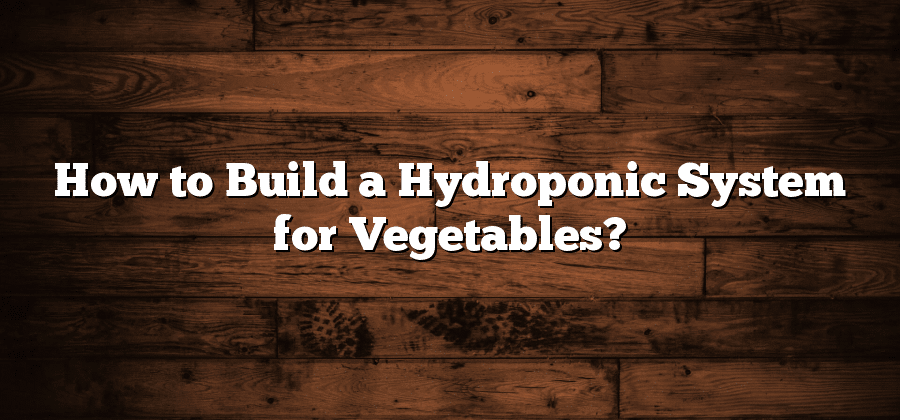Benefits of Hydroponic System for Vegetables
Hydroponic systems offer a myriad of benefits for growing vegetables. Firstly, this method allows for year-round cultivation, regardless of seasonal changes or climate conditions. By eliminating the need for soil, hydroponics also drastically reduces the risk of common plant diseases and pests. This not only ensures a higher crop yield but also reduces the need for chemical pesticides, resulting in healthier and chemical-free produce. Moreover, the controlled environment in a hydroponic system allows for maximum nutrient absorption by the plants, leading to faster growth and higher nutritional value in the produce.
Another advantage of using hydroponic systems for vegetable cultivation is the efficient use of resources. Unlike traditional farming methods that require large amounts of water and land, hydroponics utilizes water and nutrients more efficiently. The closed-loop systems minimize water wastage by recycling the nutrient solution, making it an environmentally friendly choice. Additionally, the compact nature of hydroponic systems allows for higher density planting, thus maximizing the use of available space. This makes it an ideal option for urban areas or limited gardening spaces, where land scarcity is a challenge. Overall, the benefits of hydroponics for vegetable cultivation are extensive, offering improved crop yield, healthier produce, and efficient resource utilization.
Selecting the Right Vegetables for Hydroponic Cultivation
One of the key factors to consider when selecting vegetables for hydroponic cultivation is their suitability for this growing method. Not all vegetables thrive in a hydroponic system, so it is important to choose those that are well-suited to this environment. Some vegetables that are commonly grown hydroponically include lettuce, tomatoes, cucumbers, peppers, and herbs.
When selecting vegetables for hydroponic cultivation, it is also important to consider their growth habits and space requirements. Some plants, such as vine crops like tomatoes and cucumbers, may require trellising or support structures to ensure their upward growth and prevent sprawling. On the other hand, compact plants like lettuce and herbs require less vertical space and can be easily grown in a hydroponic system with shallow water depths. Additionally, it may be beneficial to choose vegetables with a shorter growing cycle, as this allows for more frequent harvests and a higher turnover of crops.
Understanding the Basic Components of a Hydroponic System
Hydroponic systems have gained popularity in recent years due to their ability to provide a controlled environment for growing plants without soil. Understanding the basic components of a hydroponic system is essential for anyone looking to venture into this innovative form of cultivation.
One of the key components of a hydroponic system is the reservoir, which holds the nutrient solution. This solution is a carefully balanced mixture of water and essential nutrients that is directly fed to the plant’s roots. The reservoir needs to be large enough to hold an adequate amount of solution and should be made from a light-blocking material to prevent the growth of algae. In addition to the reservoir, a pump is also needed to ensure a constant flow of the nutrient solution to the plants. This helps in delivering oxygen and nutrients to the roots, promoting healthy growth.
Another crucial component of a hydroponic system is the growing medium. Unlike traditional soil-based cultivation, hydroponics requires a medium that supports the plant’s roots and allows for the proper absorption of nutrients. Common growing mediums include coco coir, perlite, vermiculite, and rockwool. These mediums are inert and provide excellent drainage, ensuring that the roots have access to both nutrients and oxygen.
In order to monitor and control various aspects of the hydroponic system, a range of tools and equipment are also necessary. pH and EC meters are used to measure the acidity and electrical conductivity of the nutrient solution. These readings help in maintaining the optimal pH and nutrient levels for the plants. Additionally, timers are employed to control the lighting cycle, ensuring that plants receive the right amount of light for photosynthesis.
Understanding and investing in the basic components of a hydroponic system is the first step towards successful cultivation. With careful selection and implementation of these components, one can create an efficient and thriving hydroponic system capable of producing high-quality vegetables.
Choosing the Ideal Location for Your Hydroponic System
Once you have decided to set up a hydroponic system for cultivating vegetables, one of the most important considerations is choosing the ideal location for your setup. This decision can significantly impact the success of your hydroponic venture. The ideal location should provide adequate space, proper environmental conditions, and easy access for maintenance.
First and foremost, you need to ensure that you have sufficient space to accommodate your hydroponic system. The size of the system will vary based on your needs and the number of vegetables you intend to grow. Make sure to choose a location that can accommodate both the system itself and the plants that will be growing in it. Additionally, keep in mind that you may need to expand your setup in the future, so it is advisable to select a space with some flexibility.
Step-by-Step Guide to Building a Hydroponic System
Building your own hydroponic system can be a rewarding and cost-effective way to grow a variety of vegetables. To get started, you will need a few key components. First, you will need a reservoir to hold the nutrient-rich solution that will feed your plants. This can be a simple plastic container with a lid and a hole for a water pump. Next, you will need a water pump to circulate the nutrient solution through the system. Look for a pump that is quiet, energy-efficient, and has adjustable flow settings. Additionally, you will need a set of growing containers, such as net pots or trays, to hold your plants. These containers should be capable of holding the growing medium and allowing the roots to access the nutrient solution. It’s important to choose a high-quality growing medium that provides good drainage and aeration for the roots.






